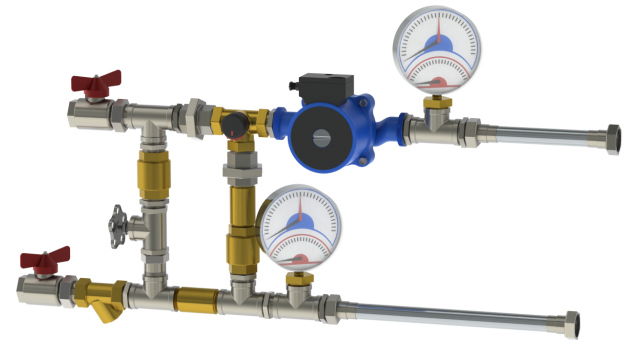
Mixing units
Description, scope
Mixing units are most important part of any modern ventilation system with a water heater. It ensures the required amount of coolant supply, thereby ensuring the supply air heating to the required temperature.
The mixing unit, being an integral part of the heat exchanger module, largely determines the quality of ventilation system as a whole. Its main purpose is safe control of the heat exchangers power in the air-supply ventilation installations, which makes it possible to protect the equipment and to improve significantly the energy efficiency.
Eurovent PA produces mixing units for central air conditioners and airheat curtains in Standard and Standard Plus versions (special versions).
Special version includes air-supply and air-supply-and-exhaust ventilation units to which no specific standards can be applied. Such equipment includes corrosion-resistant air-supply units with reversible air flow inside the unit, horizontal-vertical version units, units with offset ventilation group. Air-supply units with different air consumption, for example, in the heater and the cooler; corrosion-resistant units with stainless steel housing outside and inside with heat exchangers and a corrosion-resistant steel fan.
As a rule, such equipment is completed with mixing units and a complex automation system, cabinets of which control from one to ten air-supply units. There can be technical solution, where the control cabinet is built into the supply unit, and the mixing unit is also built-in .
Distinctive features:
The mixing unit includes:
- Circulating pump, which ensures continuous circulation of coolant through the heat exchanger;
- Three-way valve with electric drive, which controls the coolant temperature before the heat exchanger;
- Feed water filter;
- Indicating thermometers and manometers;
- Regulating valve and check valves for regulating coolant flows;
- Ball valves for shutting down the mixing unit with heat exchanger from the heating network.
By means of a three-way valve, the hot coolant (from the heating system, from the boiler) and the cooled one (after the heat exchanger) are mixed, thereby smoothly regulating the heat exchanger power. If it is necessary to operate the heat exchanger to full capacity, the straight channel shall be fully opened in the valve and all the water from heating network will flow through the large loop via the heat exchanger and then back to the heating water collector.
If the heat exchanger is not required to operate at full capacity, the three-way valve starts to mix some of cooled water after the heat exchanger thereby gradually decreasing the temperature of water supplied to the heat exchanger.
If the heat exchanger is too hot, all the water will circulate only through a small (internal) loop without mixing with hot water from the heating network. In order to avoid complete absence of water flow in the boiler loop, the mixing unit is equipped with bypass, which returns the excess of hot water to water collector through bypass. The bypass has a non-return valve and a control valve, which serve to set the optimum bypass pressure loss. The bypass serves to equalize the pressure in order to preventthe pumps interference, i.e. change of water flow through the air-heater, and also prevents the cooling of water in the boiler loop.
The circulation pump serves only to overcome pressure losses in the heat exchanger and in components of the mixing unit itself.
Calculation and competent selection of the mixing unit elements, its qualified assembly and installation are important stages of production process requiring availability of appropriate experienced specialists. A properly constructed and assembled mixing unit will allow avoid a large number of problems during adjustment and further operation of the ventilation system in general.
